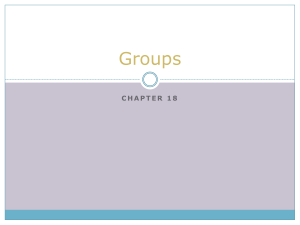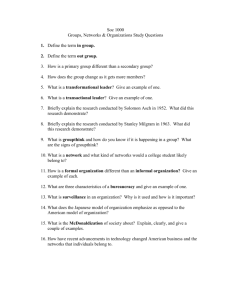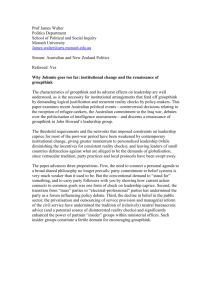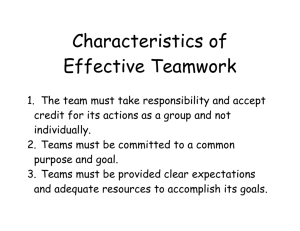Team Jeopardy.
advertisement
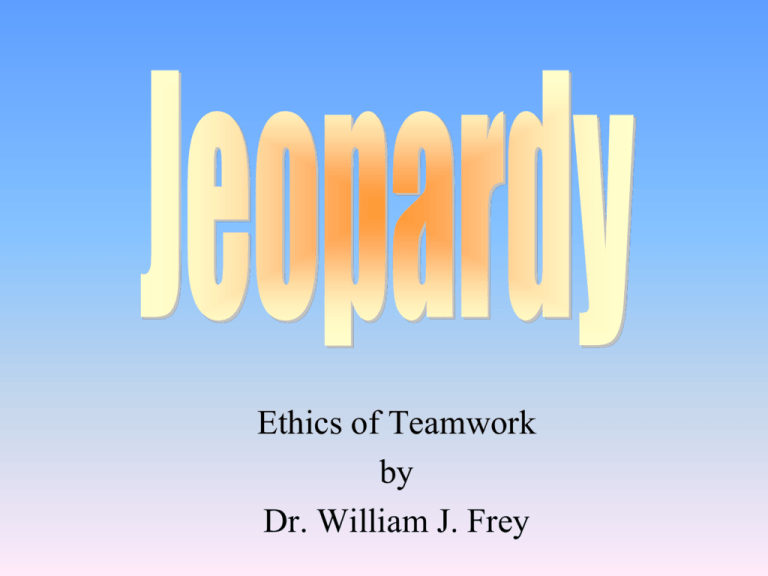
Ethics of Teamwork by Dr. William J. Frey Group Pitfalls: The Big Three More Group Pitfalls Negotiating Strategies Value Realization 100 100 100 100 200 200 200 200 300 300 300 300 400 400 400 400 500 500 500 500 What is Groupthink? A situation in which groups come to agreement at the expense of critical thinking Row 1, Col 1 What is Conflict of Effort? An individual has too many commitments and has trouble participating in group work due to these conflicting commitments. 1,2 What is Expanding the Pie? Conflicts that arise from situational constraints can be resolved by pushing back those constraints through negotiation or innovation. 1,3 What is value discovery? “The goal of this activity is to [identify] the values that are relevant to, inspire, or inform the work of a given group.” 1,4 What is Group Polarization? This phenomenon occurs when members magnify and exaggerate non-agreement and convert it into disagreement and opposition 2,1 Who are Outliers? Often mistaken for free riders, these individuals have trouble integrating into group activities because other members are closely related and share many experiences and understandings. 2,2 What is Bridging? Finding a higher order interest on which both parties agree, and then constructing a solution that serves that agreed-upon interest. 2,3 What is value translation? This phase of the value integration process focuses on the operationalization of values (by developing procedures) and the implementation of values (by carrying out these procedures). 2,4 What is Going to Abilene? A group makes unnecessary compromises because of a breakdown in group communication. 3,1 Who are Free Riders? These individuals attempt to benefit from the other members of the group without contributing anything themselves. 3,2 What is Nonspecific Compensation? One side makes a concession to the other but is compensated for that concession in some other way. 3,3 What is value verification? In this phase of value integration, groups develop assessment strategies to confirm that value goals have been realized. 3,4 How does one avoid groupthink and going to Abilene? Designate one member a devil’s advocate who is responsible for criticizing the group’s decision. 4,1 What are Hidden Agendas? These are good ideas that group members keep to themselves and do not share with the rest of the group. 4,2 What is Logrolling? Each party lowers their aspirations on terms that are of less interest to them, thus trading off a concession on a less important item for a concession from the other on a more important item. 4,3 What is a value realization procedure? This is a sequence of actions that, carried out in proper order, facilitate the integration of a given value into a specific situation. 4,4 What is a strategy for avoiding Groupthink? "The leaders in an organization's hierarchy, when assigning a policyplanning mission to a group, should be impartial instead of stating preferences and expectations at the outset." 5,1 What is negotiate interests, not positions? When caught in a strong disagreement with another individual, this strategy often helps to move things forward. 5,2 What is Cost-Cutting? One party makes an agreement to reduce its aspirations on a particular thing, and the other party agrees to compensate the party for the specific costs that reduction in aspirations involves 5,3 What is a Value? “A claim about what is worthwhile, what is good. [This] is a single word or phrase that identifies something as being desirable for human beings.” 5,4 Groupthink by Irving Janis • Defects in decision-making that contribute to groupthink (10): – group fails to consider “enough” alternatives – group does not identify goals and values of action – group fails to criticize course favored by majority or by leader – groups do not consult experts or get outside view – groups show “selective bias” regarding information they in – groups fail to identify obstacles to implementation of decision Schedules and Normal Accidents • Charles Perrow in his book, Normal Accidents, points out the dangers of systems that are “tightly coupled” and exhibit “non-linear causality.” • Schedules with no flexibility can be described as tightly coupled. • Hence a breakdown in one part of the schedule (your boss asks you to work extra hours) “spills over” into other areas (you miss class and fall behind). • In this way, small failures—because they cannot be isolated—turn into system breakdowns • Solution: when you set up your schedules at the beginning of the semester, leave flexibility that can absorb isolated, unexpected, events. Negotiation • In negotiation, you try to find ways of exiting from a conflict that benefit both parties. • Gunsalus (The College Administrator’s Survival Guide) devotes a chapter to negotiation. She identifies several steps (82-91) – opening stage, collecting information, identifying values important to both parties, “horse trading,” and confirming the agreement. – one useful suggestion: multiply interests by “expanding the pie” Weston on integrating values • Weston discusses integrating values in A Practical Companion to Ethics 56-60. His examples are quite illuminating – “If both sides (or all sides) are to some extent right, then we need to try to honor what is right in each of them. We need to take account of all the important values at stake, rather than just a few.: 56 – “integrating values calls upon problem-solving skills: generating new options and reframing problems. – We are concerned to identify the compatibility of seemingly incompatible values, to find ways to achieve or to honor both (all) of them.”57 Value Polarization • Weston identifies two aspects of value polarization (Companion, 50-51) – First, we reduce an issue to a choice between polar opposites. – Second, we choose one of these opposites over the other, labeling it right, the other wrong and good while the other is bad or evil. • We respond to value polarization, according to Weston, by generating more options and reframing the situation – Win-win rather than win-lose Value-Integration • From: – M. Flanagan, D. Howe, and H. Nissenbaum, “Embodying Values in Technology: Theory and Practice,” in Information Technology and Moral Philosophy, Jeroen van den Hoven & John Weckert, Eds. Cambridge, UK: Cambridge University Press, 2008, pp. 322353. • “Translation is further divided into operationalization, which involves defining or articulating values in concrete terms, and implementation which involves specifying corresponding design features” [4, pp. 338]. • Ethics of Teamwork transfers this framework from software development to teamwork Going to Abilene: The Story • Four people, a married couple and the wife’s parents, decide to go to Abilene and eat at a cafeteria there. • When they return home after a long hot ride, they find out that no one really wanted to go to the cafeteria. It seems the food is really lousy. • But each conceded because he or she (mistakenly) thought this is what the others wanted. Sources on Values • Brincat and Wike, Morality and the Professional Life: Values at Work, Prentice-Hall, 2000, 141. • See also, Victoria S. Wike, “Professional Engineering Ethical Behavior: A Valuesbased Approach,” Proceedings of the 2001 American Society for Engineering Education Annual Conference and Exposition.

